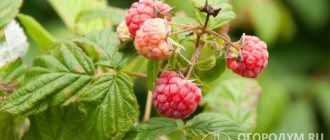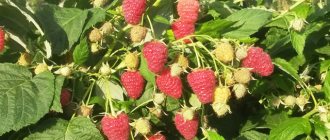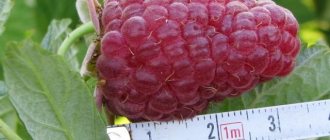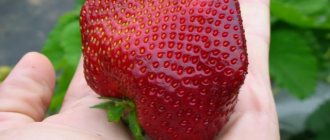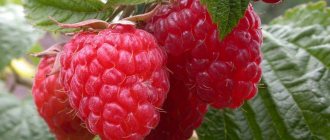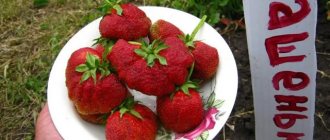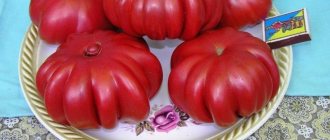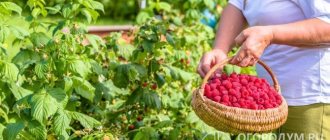The history of the Mirage raspberry began in 1976, and only in 1980 it was given the status of a variety, and it received this name. It was produced by V.V. Kichina, crossing a hybrid from Jennings from Scotland and Large Dvuroda.
AGRO PREMIUM is an innovative, environmentally friendly plant activator, without chemicals, that protects berries, fruits and vegetables from pests and diseases, increases seed germination, stimulates root formation and plant growth, and significantly increases productivity.
But raspberries never made it into the State Register, although they are popular among private owners and small farms. Raspberry of two-year fruiting. Begins to bloom at two years old. She does not require special agrotechnical care.
Botanical description
Mirage belongs to the mid-season, medium-growing varieties of the two-year cycle category. It tolerates frost well and can grow in the North, provided the bushes are insulated for the winter. Suitable for growing on an industrial scale, but also widespread in small garden plots.
Bushes. They are classified as medium-sized, the height does not exceed 1.8 m. Quite branched.
Escape. Mirage is characterized by high shoot formation: replacement shoots are formed from 9 to 11, the number of root shoots on the bush reaches 8 pieces. The shoots of the first year of life have a brownish tint and soft purple thorns. They have slight pubescence and a light coating of wax. The shoots of the second year are weakly geniculate, grayish in color, with prickly short thorns along the entire length of the branch. The variety bears fruit on branches of the second year of life (laterals). The formation of fruit shoots begins in the previous summer. As a rule, quite a lot of laterals are formed, each of which produces from 15 to 20 flowers.
Leaves. Corrugated, strongly curled and pubescent.
Berries. Cone-shaped, red, without gloss or pubescence. Very dense, do not crumble, tolerate transportation well. The taste is sweet with a slight sourness. Depending on the place of growth and care, the weight ranges from 4–6 g. But if favorable conditions are created, larger specimens weighing 10–12 g can be achieved.
Did you know? Raspberries are one of the most ancient berries. The first raspberry bushes were discovered by the Romans back in the 3rd century BC. e. on the island of Crete.
Reviews about the variety
Mirage raspberries are suitable for making very tasty and healthy jams and compotes. Preparations using ripe berries of this variety are distinguished by their extraordinary taste and aroma. According to reviews from gardeners, the variety is very worthy and has an excellent taste of berries, the drupes of which are uniform and have average adhesion to the fruit. The plants are easy to care for and are well suited for cultivation by novice gardeners, but maximum yield can be achieved under conditions of high agricultural technology and optimal weather conditions.
Characteristic
In order for the selected variety to meet expectations, you should carefully study all its characteristics and evaluate the possibility of cultivation with maximum results in the existing climatic conditions, taking into account all the advantages and disadvantages of the crop.
Drought resistance, frost resistance
Mirage is highly frost-resistant and can easily tolerate temperatures down to -25°C in winter. At the same time, well-ripened stems do not need to be bent down. But if stronger frosts are expected, it is recommended to cover the branches by first bending them to the ground.
It is resistant to drought, but prolonged lack of moisture leads to a decrease in the size of the berries. During the heat, the fruits are not baked. During heavy rains (with an excess of moisture in the soil), there is no wateriness of the berries or a decrease in their sweetness.
Did you know? Raspberries are an excellent remedy for combating hangovers due to their high content of fruit acids.
Productivity and fruiting
The bushes begin to bear fruit in the second year. You can get up to 6 fees in one season. On average, one bush produces up to 5 kg of aromatic berries, or about 20 tons per hectare.
Video: Fruiting of Mirage raspberries
Advantages and disadvantages
Gardeners highly appreciated the advantages of the Mirage variety, thanks to which for many years it has remained one of the most common in garden plots.
- The advantages include:
- good taste, pronounced aroma, large berries;
- fruit density;
- high yield, simultaneous ripening of berries;
- resistance to frost, drought and heat;
- ability to easily tolerate high humidity;
- transportability.
- There are not many disadvantages to this variety:
- the complexity of the tying process;
- susceptibility to growth virus.
Characteristics of berries
The bright red, fragrant bunches of berries that literally strew the entire Mirage raspberry bush at the time of fruiting cannot but cause delight and surprise. The berries are characterized by the following parameters:
- The size of the fruit can be from large to very large: without much effort you can get berries weighing 4-7 grams. When using intensive agricultural technology (regular and abundant watering and fertilizing), the weight of the berries easily reaches 10-12 grams. The berries from the very first harvest are especially spectacular.
- The shape of the berries can be called elongated-conical.
- The berries on the bushes are quite even.
- Color – bright red, matte, without pubescence.
- The berries are not subject to falling from the bushes or shrinking, and are held quite firmly on the stalks.
- Medium sized bones.
- The taste of the berries is excellent, they are not just sweet, but dessert-like with a slight touch of sourness, which gives a feeling of complete harmony. The intense raspberry aroma is felt several meters away and completes the picture.
- Even during periods of prolonged rain, the berries do not lose their sweetness and do not become watery.
- In the sun, the berry is resistant to baking and does not wither.
- The density of the berries is quite sufficient to withstand short transportation.
- The use of Mirage berries is universal; they can be eaten fresh, dried, and used to make numerous preparations for the winter, from compotes to jam and marshmallows.
Landing Features
A correctly selected site, compliance with the rules and timing of planting are the key to the health of the bush and a good raspberry harvest.
Deadlines
Plants can be planted both in spring and autumn. Many gardeners prefer to propagate raspberries in the fall. In this case, the adaptation time in the spring is reduced, due to which the plant immediately begins to actively grow and develop quickly. Autumn planting begins in the second half of October. In the spring they are planted after a stable above-zero air temperature has been established.
Choosing a suitable location
As a rule, a crop bears fruit well in one place for no more than 9 years. Then the raspberry tree should be moved. For raspberry beds, it is best to choose a sunny area that is well blown by the wind. A shady area is not recommended, as the branches will stretch out and the fruits will not be sweet and of good weight.
Although the variety easily tolerates spring flooding, lowlands are best avoided. The depth of groundwater must be at least 150 cm. The optimal soil acidity for the crop is 5.6–6.5.
You can also find out why raspberry leaves turn yellow.
Selection and preparation of planting material
To avoid any doubt about the quality of planting material, it is recommended to purchase it from nurseries or trusted places. Raspberries can be planted in the form of green sprouts, potted seedlings, annual and biennial seedlings.
Sprouts. They are shoots up to 15 cm high, which are sold together with a lump of earth. They must be planted in the garden bed within one to two days after digging.
Seedlings in pots or cassettes. Obtained by cloning in a special test tube. Can also be rooted from artificial fog cuttings or from mother rhizomes. They can be purchased in separate pots, so they can be left out of the ground for a long time if the conditions for planting are unfavorable. Another advantage of such seedlings is that they take root well and cannot be infected with diseases or pests.
Important! If it is not possible to immediately plant the purchased seedling in the ground, the best way to preserve its viability is to dig it in.
Annual seedling. The most common type.
This can be one or several branches up to 30 cm high without leaves. They are harvested in the fall, when the growing season of plants is over. Two-year-old seedling. It is a transplanted annual plant that is subject to additional growth during one season. The root system of such plants is well developed; as a rule, there are rudiments of new shoots. Such material costs more than annual material and in the first year after planting it already produces a harvest.
The signs of a quality seedling are as follows.
- It is a woody stem 20–40 cm high. The thicker the shoot, the better: its diameter should be at least 0.5 cm. To avoid purchasing a dry specimen when choosing a seedling, you can carefully scrape the bark, under which there should be a green layer.
- The rhizome should have green buds, which are the rudiments of new branches. The more such rudiments, the better.
- The roots of the seedling must be healthy and have at least two branches no shorter than 10 cm. It is important that the root system is moist and dense, and does not have damaged, rotten or frozen areas.
Video: Features of planting raspberries
Landing algorithm
The planting process includes several stages:
- Site preparation . In the selected area, weeds are pulled out, after which they are dug up to a depth of 20–30 cm. You can scatter humus over the bed before digging. Then there is no need to add organic matter during planting.
- Choosing a planting scheme . Considering that the Mirage variety has good shoot-forming ability, the optimal parameters for planting will be: - distance between seedlings - 0.3–0.4 m; — distance between rows — 2–2.5 m.
- Preparation of seedlings . The best option is to plant planting material immediately after purchase. The shoots with rhizomes are removed from the film and soaked in water for 2-3 hours. You can use a solution of a root formation stimulator, for example, “Kornevin”, “Radifarm”. If the seedlings are not planned to be planted immediately, it is necessary to place them without removing them from the packaging in a cool, dark place.
- Planting. For planting, you need to dig holes measuring 30x30x30 cm. Humus or compost mixed with soil should be poured into the bottom. Add a small layer of soil on top. Water the soil well. Seedlings must be planted to the depth of the root collar. Planting too high can lead to freezing in winter or drying out during dry times. And a low planting will prevent the development of replacement shoots, which can lead to the death of the plant. After planting, the above-ground part of the shoot is cut off using pruning shears.
- The final stage . To reduce the rate of moisture evaporation from the soil and protect against weeds, it is recommended to mulch the soil around the seedlings. For this you can use humus, non-acidic peat, straw.
Advantages and disadvantages of Mirage raspberries
Raspberry Mirage is different:
- high, stable yield and smooth ripening of berries;
- ability to survive after spring floods;
- tasty, aromatic, large fruits;
- dry detachment of fruits and non-shattering;
- good keeping quality and transportability.
There are also disadvantages, which are that:
- Bushes with weak immunity to growth.
- Plants must be grown on supports.
Bottom line
More on the topic: Remontant raspberry Elegant
Raspberry Mirage is a promising variety for cultivation. Although it is inferior in some indicators to other raspberry, large-fruited plants.
She has a stable yield. Excellent taste. Unpretentiousness. A raspberry plant can stay in one place for 8 to 9 years.
Care
The Mirage variety is not demanding in terms of care. However, novice gardeners need to remember a few rules for caring for raspberry bushes.
The process of caring for raspberry bushes includes the following operations:
- Watering. Raspberries are a moisture-loving plant, so from spring to late summer they should receive a sufficient amount of moisture. It should be remembered that there is no need to over-fill the bushes.
- Trimming. The first pruning is done immediately after planting, when the shoots are pruned within 0.2 m. After the first year, pruning is done in the fall after the entire crop has been harvested. You can do this in the spring, cutting off old branches at the base.
- Weeding. The best way to reduce the time spent caring for raspberries is mulching. If this is not done, you should regularly weed and loosen the soil to a depth of 0.5–1 cm.
- Garter. A technique that allows you to prevent damage to branches under the weight of fruits, preserve the health of plants (ventilation of bushes prevents fungal diseases), ensures uniform illumination of all branches by the sun and facilitates harvesting. For tying, the fan method is most often used, in which two posts are driven between the bushes, to each of which part of the branches from one bush and part of the branches from another are tied at different levels. Also convenient is the trellis garter method, when two posts are driven in at different ends of the row, between which a wire is pulled. The shoots are tied to the wire at a slight angle.
- Feeding . Raspberries feel good without additional nutrition. But in order for the bushes to delight with abundant fruiting, you can use both organic matter and mineral fertilizers, which are recommended to be applied in the fall. It is also useful to fertilize raspberries with wood ash.
Mirage raspberry planting algorithm
Experienced gardeners adhere to the trench planting method. This makes it easier to care for Mirage raspberries and prepare them for winter.
Trenches are dug 40 to 50 cm wide and 60 to 70 cm deep.
The bottom of the trenches is covered with small stones and sand. pieces of wood, branches. This results in drainage.
Fertile soil is poured to a depth of 20 cm. The edges of the trenches are reinforced with roofing felt, slate or polycarbonate.
Then water is poured into the ditch. The ends of the trench are made with 1 m supports. Wire is pulled over them, in 2 rows. From 30 to 40 cm in height, and the second at a height of 40 to 50 cm.
Raspberries are planted in the center with a distance from each other. Then they fall asleep, tamp, water and tie the shoots to the bottom wire.
More: How to make raspberry jelly
More on the topic: Yellow remontant raspberry Beglyanka
Harvesting and storage
The Mirage variety is distinguished by dense berries and excellent transportability. But, despite this, when collecting, you should adhere to some recommendations that can lead to a loss of fruit quality and a reduction in their shelf life:
- Berries should be collected in clean containers in which they are intended to be transported. Since raspberries are a very delicate berry that can easily be damaged under the weight of its own weight, the optimal container volume is containers from 1 to 0.5 kg.
- Harvesting should begin with the appearance of the first ripe berries with an interval of 1-2 days, depending on the intensity of ripening.
- In order for the fruits to withstand transportation well, they are torn off with the stalk.
- Harvesting must be done in the morning after the dew has dried. You can also do this in the evening, the main thing is that the berries are not overheated and wet.
- Until transportation (use), berries should be stored at a temperature of 0 to +1°C and a relative humidity of 85%. In such conditions, fruits can be stored for up to 4 days.
Find out in more detail how to feed raspberries during fruiting.
Landing
Raspberry Mirage loves sunny areas of the garden, plenty of moisture and nutrients. The plant is very responsive to the application of fertilizers, and therefore, when planting, it is necessary to provide Mirage with a full range of organic and mineral substances necessary for growth and development.
Raspberries “love” loose, slightly acidic soil. The optimal growing method is tape. Dig a trench (depth - 35 cm, width - 55 cm), put in it a couple of buckets of humus or rotted compost (the dosage is indicated for 1 linear meter of trench), superphosphate (160 g), potassium salt (75 g). Potassium salt can be replaced with wood ash (0.5 kg). Fertilizers are sprinkled with soil and raspberry bushes are planted, carefully straightening the roots in different directions and making sure that they do not bend.
If the soil was not abundantly filled when planting Mirage, the situation can be easily corrected by the annual autumn addition of organic matter. Rotted manure or compost, which is scattered over the surface of the raspberry tree, is suitable. This fertilizer solves two problems at once: it enriches the soil with essential nutrients and serves as mulch, which prevents the soil from drying out, protects against weeds, and keeps the soil loose. Feeding raspberries with infused mullein in May has also worked well.
Preparing for winter
Preparing raspberries for winter involves pruning and winterizing. The shoots are pruned immediately after the last harvest. The purpose of autumn pruning is to correct the distance between bushes, which makes harvesting easier the following summer. To do this, cut off branches older than two years, as well as diseased and weak shoots.
The optimal number of branches on a bush after pruning before wintering should not exceed 7 pieces. Also important is to remove leaves from branches. Old leaves on the branches lead to increased dampness and rotting of the buds.
The raspberry variety Mirage satisfactorily tolerates frosts down to -25°C. In harsher winter conditions, bushes need insulation. Bushes should be insulated in late autumn before the onset of the first frost. In regions with snowy winters, it is enough to bend the branches to the ground. Snow cover will provide reliable protection from severe frosts.
But it is necessary to ensure that no ice crust appears on the surface of the snow cover. If this happens, the ice cover must be removed, ensuring air access to the root system of the plants. If a small amount of snow falls in the region, the raspberry branches bent to the ground must be insulated with foliage, the layer of which must be at least 30 cm. You can also wrap the shrubs with a special film, providing holes for air access.
We suggest you familiarize yourself with how to fertilize raspberries in the fall.
Reviews
I have been growing the Mirage variety in my Moscow region for a long time. I don’t know why everyone is trying to keep up with something new. The variety is tasty and productive and unpretentious, in my opinion, it will outshine all these new expensive seedlings. I wouldn't trade my raspberries for anything.
Very aromatic berries. My grandchildren first of all run to the Mirage bushes and only then agree to eat other varieties of raspberries. The berries themselves are universally used, so we have time to eat ourselves and stock up on plenty. The variety's transportability is also excellent, so you can safely send raspberries to relatives and not be afraid that you will deliver a mess.
Mirage differs favorably from other remontant raspberry varieties by its excellent taste characteristics, abundant harvest and relative unpretentiousness. The plant needs timely pruning, regular watering and fertilization.
Reproduction methods
Raspberries propagate quite easily, and each gardener finds his own optimal way, which works best for him:
- Reproduction by lignified offspring. Offshoots are formed from buds on the roots of the plant. The healthiest and strongest bushes are chosen for propagation. Annual suckers growing at a distance of at least 0.3 m from the parent bush are dug up from early September to October. You should try to preserve the maximum number of roots, the length of which should be at least 12 cm.
- Reproduction by green offspring. The method is used only in spring. Dig out green young shoots 0.1–0.2 m high, formed from shoot buds on the roots. In order not to damage the mother bush, they retreat approximately 0.4 m from its center and dig up a green shoot with an earthen lump. Green shoots must be grown in a separate bed and only planted in a permanent place in the fall.
- Propagation by root cuttings. It is often used when raspberry stems are affected by any diseases. This method can be used to propagate raspberries both in spring and autumn. To do this, step back approximately 0.4 m from the center of the bush and carefully dig out the ground around the root. Then carefully dig up the root with cuttings. Healthy roots with a diameter exceeding 2 mm are divided into pieces 9-10 cm long, each of which has at least 1 bud. For cuttings, you can use a bed or greenhouse with loose, fertile soil. The prepared material is planted in furrows 7–10 cm deep without gaps. Sprinkle with fertile soil and water.
- Propagation by green cuttings. For this method of propagation, suckers from the roots obtained by thinning raspberries in the period from May to June are suitable. The shoots must have at least 2 leaves and a length of 8–15 cm. The resulting branches are cut to ground level and tied into bundles of 10–15 pieces. and placed for 15–17 hours in a Heteroauxin solution with a concentration of 0.1%. After this, the cuttings can be planted in a greenhouse. After 21–30 days, the cuttings are dug up and transplanted into open ground for growing.
- Reproduction by dividing the bush. Used for propagation of valuable raspberry varieties, which are characterized by a small number of offspring from root buds. When dividing a bush, it is important to leave well-developed roots and at least 2 strong young shoots in one part. One healthy bush can thus be divided into 4-5 full-fledged seedlings.[img
Description of the variety
- The Moscow giant is characterized as early ripening, semi-remontant, highly productive, with a long harvest period;
- The shrub is characterized by rapid growth of shoots, compactness, and abundant green mass;
- The branches of the bush are powerful, grow up to 2 meters in length, smooth, without thorns. During the season, up to 8 replacement shoots are formed, up to 5-6 basal shoots. The shoots are marked by strong branching of lateral branches bearing berry clusters, which determines the high yield of the variety. Under good weather conditions and proper care of the plant, the strongest shoots of the first year can produce a harvest. Fruit clusters in this case are few in number; they are located on the upper part of the stem. The next year, the non-fertile part of the shoot will give a full harvest along its entire length;
- The leaves are very large, wrinkled, bright green in color, with a bumpy, loose texture;
- The berries are bright red, huge in size, on average 4-4.5 cm, weighing up to 20-22 grams. They have an elongated conical shape, a perfectly smooth, shiny surface. The drupes are large with small seeds. The pulp is dense, very juicy, sweet and sour in taste, with a pronounced raspberry aroma. Due to their elasticity and fleshy consistency, the berries can withstand long-term transportation and storage when assembled. Since the berries do not leak during and after picking, they are better suited for freezing than other varieties. The berries are also used to make liqueurs, preserves, jams, and decorate desserts.
- The yield of the Gigant Moscow variety is 9-10 kg. from one bush.
Advantages of the variety
- high productivity;
- large fruits;
- good transportability of berries;
- high marketability and taste of berries;
- ability to produce two harvests per season;
- self-pollinating;
- absence of thorns.
Disadvantages of the variety
- characterized by strong growth of green mass of the bush;
- little knowledge of the variety in terms of growing it in northern latitudes.
Diseases and pests
The Mirage raspberry variety is not classified as capricious, however, like most other representatives of this crop, it is susceptible to a number of diseases and pests that can significantly reduce yields and sometimes lead to the death of plants.
Important! Raspberries should not be sprayed with any preparations during the flowering period.
Raspberry diseases
Most often, raspberry bushes are exposed to bacteria, viruses and fungi, leading to various diseases:
- Rust. It is fungal in nature and appears on the surface of the leaves in the form of small orange growths. One-year-old shoots are covered with gray spots with an orange border, in place of which cracks appear. The disease appears in early spring and, if adequate measures are not taken, by July it can cover most of the raspberry tree. Sick and healthy plants (to prevent infection) should be sprayed in early spring with a solution of Bordeaux mixture (3% concentration). Repeated treatment with a 1% solution of the same drug must be done before flowering begins. As a preventive measure, autumn mulching of raspberries with manure is recommended. Diseased plants must be destroyed.
- Didimella (purple spot). A fungal disease that leads to premature leaf shedding, reduced yield and frost resistance. It appears in the form of reddish fuzzy spots on one-year-old shoots. First, the spots appear on the stem, then they grow and lead to drying out of the shoots. Later, the color of the spots becomes dark brown, and they develop into brown tubercles. The diseased plant must be cut off, because next year fungal spores will ripen in these tubercles and continue to infect healthy specimens. To combat the disease, raspberries are sprayed in the fall with Nitrafen or a 1% solution of copper sulfate. You can repeat the treatment in early spring until the buds awaken with Bordeaux mixture with a concentration of 1%.
- Powdery mildew. As a rule, it appears in dry and hot weather. Leaves and tops of young shoots, as well as berries, are affected. Appear as light spots. They lead to stunted growth, bending of stems, yellowing and shedding of leaves. After the harvest is harvested, all shoots are cut out and burned, the leaves are collected and burned. All bushes are treated three times with Bordeaux mixture.
- Anthracnose. The cause of the disease is a microscopic fungus. Appears on the leaves in the form of small gray spots with a purple border. The defeat causes the complete death of young shoots. Treat the raspberries with Bordeaux mixture at a concentration of 1% until the buds open. Repeat the treatment three times: when the young shoots reach a height of 20 cm, then before flowering and a third time after the harvest. For prevention purposes, it is necessary to thin out the raspberry beds, remove all shoots that bear fruit, and remove weeds in a timely manner.
Raspberry pests
The greatest danger to crops are crawling insects, which can cause a lot of trouble even for experienced gardeners:
- Raspberry-strawberry weevil. It is one of the most common pests and can destroy up to 50% of the crop. Signs of infection are eaten flowers and anthers in the buds. To prevent and control the pest, it is necessary to treat the raspberry tree with insecticides before flowering. Re-treatment should be repeated after harvesting.
- Stem gall midge. A small, light brown fly that lays eggs at the base of young shoots. The infection manifests itself as swellings on the branches, similar to a tumor. The branch breaks off at the site of the swelling, which reduces the yield. The color of the swelling is brown, the size does not exceed the size of a nail. Diseased branches must be cut off and burned. The bushes are treated with systemic insecticides (Biotlin or Confidor) before flowering.
- Raspberry aphid. A small pest with a body length of no more than 2 mm, yellow-green or white-green in color. Attached to the back of the sheet. Slows down growth and reduces bush yield. There is slight curling of leaves, curvature of shoots and shortening of internodes. If signs appear, you can try spraying the bushes with herbal infusions (dandelion, calendula, tansy). Effective products are “Fitoverm” and “Fufan”.
- Raspberry beetle. Small in size with a body densely covered with red hairs. It feeds on flowers and raspberries. The beetles eat young leaves, which leave small holes. Females lay eggs in buds. The hatched larvae eat the berries. To combat the pest in the fall, you should dig up the soil in the raspberry field. When forming buds, treat the bushes with Karbofos.
- Tick . A very small omnivorous spider, especially often infecting plants during drought. Among the signs: cobwebs appearing, brown spots on the leaves. Over time, the leaves dry out and crumble, the buds fall off and the raspberries do not bloom. To combat the spider, acaricides are used (Fufanon, Antio, Akreks), which should be used to treat the plant 2-3 times during the season. It is also recommended to spray with Nitrophen in early spring at the rate of 20 g of product per liter of water.
Mirage raspberries are deservedly popular among culture lovers due to their high yield, pleasant taste and excellent aroma of the berries. Beginner gardeners will not be disappointed by choosing this variety. It is unpretentious and, if you learn simple rules of care, will not cause any particular difficulties when planting and cultivating.
Growing and care
Raspberry is not such a capricious plant, but it also requires proper care. The quality of the fruit and the volume of the harvest depend on the latter.
Watering
Raspberries are very sensitive to moisture. If there is not enough of it, the bush begins to shed leaves, flowers, and berries, which should not be allowed. And with an excess of water, rotting of the root system is observed.
Raspberries absorb the most water during flowering and fruiting, therefore, provided dry, hot weather sets in, watering twice a week is optimal. At least 10 liters are applied for each bush. water to saturate the area where most of the roots are located. It is advisable not to get it on the foliage, but to pour it at the root.
Attention! Even after a short rain, raspberries should be watered, since light precipitation only adds dust. Moisture still does not reach the root system.
Trimming
Raspberry shoots are usually pruned to improve the health of the entire plant. Thus, the tops that have frozen over the winter should certainly be removed so that the plant can produce side shoots. And overgrown bushes should be divided or cut out so that the berries are not crushed.
Experienced gardeners prune to extend the fruiting period of the plant. This is done like this: in some shoots only the top is cut off, in others - 25 cm, in others - the whole half. During the fruiting period, berries appear first on those branches in which only the tops have been shortened. The last ones were on heavily pruned shoots, which had to spend a lot of effort on restoration.
When pruning, 8-10 replacement shoots are left for each bush.
Note. Mirage raspberries are pinched in late August. Thanks to it, the shoots stop growing and have time to ripen before the onset of cold weather.
Top dressing
In early spring, even before the snow has completely melted, nitrogen is added to the raspberries to make it easier for the plant to break dormancy and begin to grow. Then the Mirage variety, in addition to nitrogen, requires a set of minerals: potassium, iron, phosphorus, calcium, etc.
Nitrogen stops being applied in June. During the period of budding, flowering, and fruit set, this variety requires complex mineral nutrition.
Important! Organic fertilizers are not recommended to be applied in summer. This is especially true for fresh manure. The latter leads to increased growth of green mass to the detriment of the harvest.
In the pre-winter period, Mirage raspberries need complex fertilizer based on phosphorus.
Preparing for winter
Mirage is a relatively winter-hardy raspberry variety. It can withstand cold temperatures down to -25 degrees. If winters are more severe, the plant requires preliminary preparation for a dormant period.
If the tops of the shoots have not ripened by the end of September, they will inevitably die in the winter. They are pruned, which allows the plant to spend less energy preparing for the dormant period.
In the second half of October, raspberry bushes are slightly earthed up to protect the root system from freezing.
In some regions, with early autumn frosts, abundant rainfall, and long frosty winters, the shoots are bent to the ground in order to prevent freezing during the cold season. Fallen snow covers the shoots, providing reliable protection from cold, gusty winds, and sun. Sometimes there is very little snow in winter. In this case, gardeners manually collect it from the garden, adding it to the raspberries.
Important! You should not bend the shoots too low to the ground; in very snowy winters they can be broken by the thickness of the snow. In addition, the branches can become damp from the heat coming from the ground.
Description and history of the variety
Back in 1976, one of the outstanding Russian breeders V.V. Kichina crossed two raspberry hybrids received from D. Jennings of the Scottish Institute of Horticulture as part of an exchange program, 707/75 x Large Dvuroda. As a result, a hybrid form of raspberry was obtained, which began to undergo testing at the Kokinsky stronghold of VSTISP and in 1978 received the code name K151.
Read also: Horse manure fertilizer: how to use, reviews
Only since 1980, this raspberry officially acquired the status of a variety and received the name Mirage. For some unknown reason, the Mirage raspberry variety was not included in the State Register of Russia, although it has enjoyed great popularity all these years and was even grown in some regions suitable for the climate as an industrial one. At the moment, it is slightly displaced by more productive and frost-resistant raspberry varieties, but nevertheless it has not gone away and is actively used by both private gardeners and small farms.
The bushes of this variety are moderately spread in different directions, are of medium height, reaching a height of 1.6 -1.8 meters. Fresh annual shoots have a light brown color with a red tint and a slight waxy coating without pubescence. Internodes are located at a considerable distance - every 4-7 cm. The shoots become very thin towards the apex. Two-year-old shoots are distinguished by a rather grayish tint. Soft, straight, short thorns are located along the entire height of the shoot.
Fruiting branches, the so-called laterals, branch very actively. A branch can form from three to five orders of branching, each of which, in turn, bears 15-20 berries. The dark green, strongly curled leaves of medium size are distinguished by a corrugated surface and pubescence.
The raspberry variety Mirage has good shoot-forming ability and produces about 9-11 replacement shoots. This is enough to successfully propagate bushes and at the same time restrain the growth of bushes in different directions. In addition, each raspberry bush produces about 5-8 root suckers.
Raspberry Mirage is a medium-late variety in terms of ripening. This can be very convenient to fill the gap in raspberry fruiting, when the early traditional varieties have already fruited, and the remontant varieties have not yet ripened. Mirage raspberries ripen starting from the end of June in the southern regions and in the second half of July in the middle zone. The harvest can be harvested within about a month; in 5-6 pickings the berries will be completely collected from the bush.
In terms of yield parameters, the Mirage raspberry variety still occupies one of the leading positions. From one bush you can collect an average of 4-6 kg of berries. In industrial terms, this gives up to 20 tons per hectare.
Considering the fact that the Mirage variety belongs to the large-fruited raspberry group, it is relatively winter-hardy in its category - it can withstand down to -25°-27°C. If you let the young shoots ripen well, then you don’t even have to bend them down for the winter. Although, in the conditions of the Moscow region, this variety can show sufficient frost resistance only if the shoots are bent down and covered for the winter.
But the Mirage raspberry is relatively drought-resistant and tolerates heat well.
The variety also exhibits a good degree of resistance to major fungal and viral diseases. May be somewhat susceptible only to growth virus.
Detailed description of the large-fruited raspberry variety Mirage
It is difficult to find a plot where raspberries are not grown. This fragrant, tasty and very healthy berry is a favorite treat for children and adults. There are currently many remontant and classic varieties.
Not every variety will be able to meet the taste preferences of gardeners, so everyone chooses for themselves the variety that they like. I chose the Mirage raspberry variety, which is not only in demand by many gardeners, but has excellent characteristics.
Description of the variety
The medium-ripening variety Sokolitsa was obtained in 2011 in Poland by crossing popular raspberry varieties: Polana and Molling Promise. It belongs to the summer garden raspberry, but on some shoots it can show signs of remontancy, producing crops on annual branches.
The bush is characterized by medium spreading, the stems reach a height of 170-200 cm. The trunks and fruit branches are covered with small thorns. The spines are thin, not sharp, located mainly on top. The foliage is medium in size, traditionally wrinkled, rich green in color, with narrow teeth.
The berries are of an unusual elongated shape, slightly flattened on the sides. They resemble an elongated cylinder or spindle, very large. The weight of an average fruit is 7 g. The color is rich red, with a slight shine. The berries are strong, with densely spaced drupes, and tolerate transportation well.
The yield of the variety is 170-200 c/ha, with a planting pattern of 2.0 x 0.5 m. In terms of fruiting time, Sokolitsa is comparable to another popular Polish variety - Lyashka.
Winter hardiness, by Western standards, is average. When grown in Russia, it requires obligatory shelter for the entire cold period.
Tolerates heat, dry air, and prolonged absence of precipitation well. Excess moisture is destructive for Sokolitsa - the root system suffers greatly, so it is often not worth watering.
Tying to a trellis is not mandatory, but it is advisable. This way, the long stems will not fall under the weight of the harvest and will not intertwine with each other. The garter promotes the active growth of shoots, facilitates harvesting, and serves as a preventive measure for the development of fungal diseases.
Features of the variety
The main peak of fruiting of raspberries of the Mirage variety occurs at the end of July and beginning of August. The bushes are medium-sized, no more than 2-2.5 m high, characterized by slightly spreading growth and relatively low shoot-forming ability. On average, each adult plant has about 9-11 shoots . Annual shoots are characterized by a dirty brown color, the presence of a slight waxy coating and the absence of pubescence. Raspberry leaves of the Mirage variety are small and medium-sized, corrugated, with medium-sharp teeth, green in color. There are soft, dark-colored spines.
The berries are large in size and have a slightly elongated shape. The pulp of the ripe berry is red. Berry formation is observed on thin and long fruit branches. The average number of berries on one such fruit-forming segment is from 10 to 12 pieces. At the stage of full ripening, the berries do not fall off the bushes. The pulp has a sweet and sour taste and, indeed, a simply magical berry aroma. Based on the results of the data obtained from tasting tests, it was noted that this raspberry variety was given a very high score.
Plant characteristics
The berries of this variety are large, reaching a weight of 10 grams, and the berry shape is conical. These raspberries taste juicy and extremely sweet. This variety is consumed not only fresh, but also made into all kinds of preparations. Raspberries stick well to the bush; they do not fall off or spoil in strong sun. In the middle zone, fruiting begins in July and ends at the end of August. In southern latitudes, ripening occurs half a month earlier. Over the entire season, it is quite possible to harvest up to 6 harvests.
Raspberry Mirage, or not leaving the race
A relatively winter-hardy variety - among the large-fruited forms of Russian selection, it is least prone to freezing and is not afraid of flooding during thaws. What is important to know about the Mirage variety, who is raspberry suitable for, advantages and disadvantages, description, characteristics.
Description: Mirage, brief description
Winter-hardy among large-fruited ones, large among dessert ones in the assortment of Russian selection and not only, with good presentation. Based on the totality of its qualities, the Mirage will not leave the range of assortment racing for a long time: not being the first, it will not be the last.
In the photo, Mirage raspberries are in the middle of picking.
Description of the variety with reference to the author's, based on observations of gardeners and farmers.
Authorship belongs to V.V. Kichine, one of the valuable specimens of the “large-fruited” collection of varieties. Bred at the Kokinsky stronghold of VSTISP in 1976 from crossing hybrids 707/75 x Large Dvuroda, obtained at the Scottish Institute of Horticulture in exchange with D. Jennings as part of the exchange program. Selected for selection in 1978 under number K151. It has been propagated and distributed as a variety since 1980.
In central Russia it is rarely used on large industrial plantations due to the low winter hardiness characteristic of large-fruited forms. Used mainly in amateur gardening, occasionally in small-scale production for the fresh market in limited quantities.
In the 90s of the last century, it was grown in suitable climatic zones as an industrial plant due to the lack of more productive analogues. With the advent of alternatives, it is grown in limited quantities, in small production by individual farms. The purpose is universal.
Productivity is high, up to 4-6 kg per bush on average, industrial productivity up to 20 t/ha.
In the conditions of the Moscow region, the Middle Zone, it is a late variety, ripens in the second or third ten days of July (July 15-20), and finishes before the second ten days of August. In the conditions of the south, in Ukraine - in the last ten days of June. Gives 5-6 main collections - quite friendly, not stretched out.
Raspberry care
If planting is carried out using a strip or trench method, then it is important to leave 2 meters between the rows. With another method, 1.5 meters will be enough. After planting, the root area must be covered with mulch; only the organic option in the form of vegetation (hay, peat, humus) is used. This technique will not only preserve moisture, but also the structure of the soil.
In April, it is necessary to lift all the stems, remove damaged parts, and leave no more than 10 pieces per linear meter. The plant needs to be tied up, collecting the shoots in bunches of 5 pieces. Already in May, when the plant has reached a meter in height, it is necessary to cut off the tops and pinch them. This will increase the size of the berry and the number of fruit branches. Pruning is done from above the third bud; if you trim higher, the stem will simply break from the weight of the harvest.
The Mirage raspberry variety is one of those that can easily withstand winter cold. The plant can tolerate frosts down to -25 degrees. If the region expects more severe winters, then the raspberries need to be prepared for cold weather and insulated. If the tops of the branches have not ripened by the end of September, they will certainly die with the arrival of frost. Such parts need to be cut off so that the bush does not waste energy preparing for the dormant period. At the end of October, raspberries need to be slightly earthed up to prevent the root system from freezing.
In some regions, raspberry shoots are pressed to the ground to prevent the plant from freezing. This is especially true for latitudes with long winters, large amounts of precipitation and strong winds. A layer of snow covers the branches and creates good protection from frost. Sometimes winter is not encouraging with an abundance of snow, in which case experienced gardeners collect it from the plot by hand and cover the raspberries with it. It is worth paying attention that it is impossible to press the shoots too low to the ground; if a large amount of snow falls, its thickness will simply break the branches. In addition, branches can rot from the heat provided by the earth.
Features of cultivation, pruning
Considering the average spreading nature of the bushes, when planting, leave up to 1.2-1.5 meters between them, and it is better to make row spacing about 2.5 meters wide.
Abundant mulching of bushes with organic materials will solve several problems at once: it will preserve the structure and moisture of the soil and provide additional nutrition to the raspberries.
Read also: Tomato Evpator: characteristics and description of the variety, photos, reviews, yield
Spring pruning of Mirage raspberries is quite important, since it allows you to influence both the stability and productivity of the bushes. In early spring - in April, all damaged and weak stems are removed so that no more than 8-9 shoots remain on one linear meter of planting. Then the tops of the stems are trimmed at a height of about 1.5 meters. On other raspberry varieties, additional pruning is often done at the end of May - beginning of June to increase fruiting. The Mirage raspberry variety does not need this, since it is genetically determined to form many lateral fruits along the entire stem, and not just at its top.
Fruiting stems should be cut out immediately after the end of fruiting, without waiting for the onset of autumn, in order to minimize the spread of possible diseases and infections.
In contrast to spring formative pruning, autumn is a time of primarily sanitary pruning of Mirage raspberry bushes. Only broken and weak shoots are removed, taking into account that during the winter some loss of shoots may occur due to frost.
Otherwise, to obtain good harvests, standard techniques are used: regular watering and fertilizing: in early spring with a predominance of nitrogen, before flowering with complex fertilizer, and during budding and fruiting with a predominance of phosphorus and potassium.
